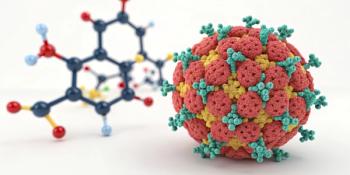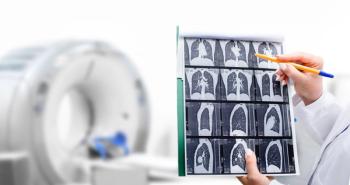
Varenicline: An oral partial nicotine agonist for smoking cessation
Varenicline (Chantix, Pfizer) is a partial nicotine receptor agonist with a high affinity for the alpha-4 beta-2 nicotinic acetylcholine receptors, modulating dopamine levels associated with nicotine addiction and aiding in smoking cessation. Clinical studies have demonstrated favorable cessation rates compared with placebo and sustained-release bupropion, with an encouraging safety profile. The most common adverse effect seen in clinical trials was mild-to-moderate nausea. In November 2005, a New Drug Application (NDA) was submitted for varenicline, and the drug was subsequently granted a 6-month priority review. On May 10, 2006, varenicline became the first oral medication approved for smoking cessation since bupropion, representing an agent with a novel mechanism of action for smoking cessation.
Abstract
Varenicline (Chantix, Pfizer) is a partial nicotine receptor agonist with a high affinity for the alpha-4 beta-2 nicotinic acetylcholine receptors, modulating dopamine levels associated with nicotine addiction and aiding in smoking cessation. Clinical studies have demonstrated favorable cessation rates compared with placebo and sustained-release bupropion, with an encouraging safety profile. The most common adverse effect seen in clinical trials was mild-to-moderate nausea. In November 2005, a New Drug Application (NDA) was submitted for varenicline, and the drug was subsequently granted a 6-month priority review. On May 10, 2006, varenicline became the first oral medication approved for smoking cessation since bupropion, representing an agent with a novel mechanism of action for smoking cessation. (Formulary. 2006;41:265–272.)
Cigarette smoking is the leading preventable cause of mortality in the United States, accounting for nearly half a million deaths, 5.5 million years of potential life lost, and $92 billion in productivity losses per year.1 Several conditions have been linked with cigarette smoking, including cardiovascular disease, chronic obstructive pulmonary disease (COPD), many cancers (lung, mouth, esophageal, bladder, pancreatic, gastric, cervical, and others), and pregnancy related complications. Second-hand smoke has also been associated with an increase in respiratory disease, sudden infant death syndrome (SIDS), cardiovascular disease, and cancers as well.2 Despite the well-established consequences of cigarette smoking, approximately 21% of the population continued to smoke in 2004. However, it is estimated that 70% of smokers would like to quit.3 Nicotine use is among the most difficult addictions to treat; the US Surgeon General has compared it to heroin or cocaine addiction. Pharmacologic effects of nicotine include stimulation of dopamine release, resulting in feelings of pleasure. With sustained nicotine use, tolerance and dependence quickly evolve, requiring the smoker to continually administer the drug in order to prevent uncomfortable withdrawal symptoms such as anxiety, irritability, increased hunger, and difficulty sleeping and concentrating.4
Another pharmacologic option has recently been developed to modify patients' nicotine cravings and withdrawal symptoms; it is the first new smoking cessation medication to be approved since the nicotine lozenge in 2002. Varenicline (Chantix, Pfizer) is a partial nicotine receptor agonist demonstrating favorable cessation rates while also offering a mechanism of action different from current first-line therapies. In November 2005, a New Drug Application (NDA) was submitted for varenicline, which was subsequently granted a 6-month priority review and approved on May 10, 2006.7
CHEMISTRY AND PHARMACOLOGY
Varenicline is the newest medication offering patients another treatment option for smoking cessation with a different mechanism of action. Varenicline is a partial agonist at the alpha-4 beta-2 nicotinic acetylcholine receptors (nAChRs) with a chemical structure 6,7,8,9-tetrahydro-6,10-methano-6H-pyrinazo[2,3-h][3]benazaprine. These specific nAChRs are postulated to be responsible for increased dopamine release when activated by nicotine, an effect seen with other drugs of abuse, leading to dependence in the nucleus accumbens and prefrontal cortex of the brain. As nicotine abstinence occurs during cessation, dopamine levels are low, associated with the withdrawal symptoms and increased cravings, which often leads patients to relapse. By competitively inhibiting the nAChRs, the patient will not be subjected to lower levels of dopamine resulting in withdrawal symptoms, but conversely will also not be rewarded by higher levels of dopamine if they were to resume smoking once again. In addition, a partial agonist offers the advantage of reducing side effects from over-exciting these receptors as nicotine can.8
PHARMACOKINETICS
After oral administration of 1 mg in human subjects, varenicline succinate reached peak concentration (tmax) in 4.3±2.3 hours with first-order pharmacokinetics. A peak of 4.01±0.71 ng/mL (Cmax) and half-life of 17±3 hours (t1/2) were also observed. Varenicline is excreted mostly in the urine (99%). It is mainly unchanged (92%), with the exception of 2 minor metabolites: varenicline N-carbamoylglucuronide and 2-hydroxyvarenicline. Each metabolite accounts for 3% and 4%, respectively, of the total drug. Pharmacokinetic profiles in both smokers and non-smokers did not differ.9 A comparison of sustained-released buproprion and varenicline pharmacokinetics can be found in the literature.10
CLINICAL TRIALS
At press time, the published clinical data available on varenicline was limited to phase 2 and phase 3 trials in abstract form only.
Oncken et al11 conducted a multicenter, randomized, double-blind, placebo-controlled trial to evaluate the efficacy and safety of 4 varenicline dosage regimens, including whether titration was clinically effective. This phase 2 trial randomized 647 healthy smokers (aged 18–65 y) to either varenicline 0.5 mg twice-daily nontitrated (n=129); 0.5 mg twice-daily titrated (n=130); 1.0 mg twice-daily nontitrated (n=129); 1.0 mg twice-daily titrated; or placebo (n=129) for 12 weeks. The first week consisted of the dose titration phase for those groups; however, the authors did not specify further details.
The primary end point was the carbon monoxide-confirmed 4-week continuous quit rates (CQRs) for Weeks 9 to 12. The CQRs were higher for those randomized to the pooled 1.0 mg twice-daily varenicline group (50.6%) than for the pooled 0.5 mg twice-daily group (45.1%). Titration was shown to have no significant effect on CQRs, but no detailed rates were given. The CQRs were significantly higher for each varenicline group compared with placebo (12.4%; P<.0001 for both comparisons). The authors also reported that varenicline significantly reduced craving and smoking satisfaction but did not specify how these effects were measured. Adverse effects included mild-to-moderate self-limiting nausea with varenicline versus placebo, but for each dose, titration did reduce overall frequency according to the authors.
Oncken et al12 conducted another phase 2 multicenter, randomized, double-blind, placebo-controlled study to evaluate the efficacy and safety of 3 varenicline doses compared with sustained-release buproprion over a period of 7 weeks. Healthy smokers aged 18 to 65 years were included. Subjects were randomized to either 0.3 mg of varenicline daily (n=127); 1.0 mg of varenicline daily (n=128); 1.0 mg of varenicline twice daily (n=127) for 6 weeks plus placebo for 1 week; 150 mg of sustained-release buproprion twice daily (titrated over the first week) for 6 weeks plus placebo for 1 week; or placebo.
The primary end point was any 4-week carbon monoxide-confirmed CQRs. The floating CQR (any 28-week period) was significantly higher for the 1.0 mg varenicline daily group (37.3%) and 1.0 mg twice-daily group (48.0%) compared with both placebo (17.1%; P=.003 and P<.0001, respectively) and for buproprion (33.3%). Varenicline 1.0 mg twice-daily was also reported to significantly reduce both craving and smoking satisfaction versus placebo. Results compared with bupropion were not mentioned for these secondary end points, nor were any efficacy data for 0.3 mg of varenicline described in the abstract. During this trial, discontinuation rates for varenicline were 11.2% to 14.3%, compared with 15.9% for bupropion and 9.8% for placebo.
Results of 2 similarly designed phase 3 trials were presented at the Scientific Sessions of the American Heart Association (AHA) in November 2005.13 Both studies were randomized, double-blind, placebo-controlled trials comparing varenicline to sustained-release buproprion and placebo for 12 weeks. In Study 1, 1,022 patients were randomized to either varenicline 1 mg BID (n=349), bupropion SR 150 mg BID (n=329), or placebo (n=344), while in Study 2, 1,023 patients were randomized to either varenicline 1 mg BID (n=343), bupropion SR 150 mg (n=340) BID, or placebo (n=340). The primary end point for both studies was carbon monoxide-confirmed 4-week CQR during Weeks 9 through 12. Continuous abstinence was also measured for both studies during Weeks 9 to 52 after all medication had been discontinued.
Both studies reported quit rates of approximately 44% in the varenicline group after 12 weeks compared with 30% in the bupropion group, and 17.7% in the placebo group. Results from both studies, as well as the continued abstinence rates through 1 year, are presented in Table 1.13,14
The continuous abstinence rate was 70.6% for those taking varenicline compared with 49.8% for placebo (P<.001). When extended to 13 to 52 weeks, which was the secondary end point, the continued abstinence rate fell to 44.0% for varenicline compared with 37.1% for placebo, although this was still statistically significant (P=.013).14
ADVERSE EFFECTS
Varenicline has been demonstrated to be safe and well tolerated in clinical studies. Mild-to-moderate nausea was the most frequently reported side effect throughout the clinical trials. Other observed adverse effects, reported in ≥10% of patients in phase 2 trials only, include insomnia, headache, abnormal dreams, changes in taste, irritability, dyspepsia, flatulence, constipation, respiratory tract infection, and asthenia.14
DRUG INTERACTIONS
Currently, information on varenicline's drug-drug interaction profile is limited; however, a pharmacokinetic evaluation was done to assess concomitant administration of digoxin and warfarin with varenicline.15 The results demonstrated that coadministration of varenicline 1 mg twice-daily had no effect on steady state plasma digoxin concentrations. The study also demonstrated that varenicline had no effect on the single-dose pharmacodynamics of warfarin as measured by the prothrombin time.
DOSAGE AND ADMINISTRATION
Varenicline is approved for dosing at 1 mg BID following a 1-week titration. The titration should begin with 0.5 mg QD on Days 1 to 3, followed by 0.5 BID on Days 4 to 7. For patients with severe renal impairment, a maximum daily dose of 0.5 mg BID is recommended. Patients with end-stage renal disease undergoing hemodialysis should receive a maximum dose of 0.5 mg QD if the drug is tolerated well.16
Dr Feret is a clinical assistant professor at the University of Rhode Island College of Pharmacy, Kingston, RI. He can be reached at
. Dr Orr is a clinical assistant professor at the University of Rhode Island College of Pharmacy.
Disclosure Information: The authors report no financial disclosures as related to products discussed in this article.
In each issue, the "Focus on" feature reviews a newly approved or investigational drug of interest to pharmacy and therapeutics committee members. The column is coordinated by Robert A. Quercia, MS, RPh, director of Drug Information Services at Hartford Hospital in Hartford, Conn, and adjunct associate professor, University of Connecticut School of Pharmacy, Storrs, Conn; and by Craig I. Coleman, PharmD, assistant professor of pharmacy practice, University of Connecticut School of Pharmacy, and director, Pharmacoeconomics and Outcomes Studies Group, Hartford Hospital.
EDITORS' NOTE: The clinical information provided in "Focus on" articles is as current as possible. Due to regularly emerging data on developmental or newly approved drug therapies, articles include information published or presented and available to the author up until the time of the manuscript submission.
REFERENCES
1. Centers for Disease Control and Prevention. Annual smoking-attributable mortality, years of potential life lost, and productivity losses-United States, 1997-2001. MMWR. 2005;54:625–628.
2. The Health Consequences of Smoking: A Report of the Surgeon General. Atlanta, Ga: US Department. of Health and Human Services, Centers for Disease Control and Prevention, National Center for Chronic Disease Prevention and Health Promotion, Office on Smoking and Health, 2004. Available at: http://
3. Centers for Disease Control and Prevention. Cigarette smoking among adults-United States, 2004. MMWR. 2005;54:1121–1124.
4. The Health Consequences of Smoking: Nicotine Addiction: A Report from the Surgeon General. Atlanta GA: US Department of Health and Human Services, Centers for Disease Control and Prevention, National Center for Chronic Disease Prevention and Health Promotion, Office on Smoking and Health, 1988. Available at: http://
5. US Public Health Service. Treating tobacco use and dependence-clinician's packet. A how-to guide for implementing the public health service clinical practice guideline, March 2003. Available at: http://
6. University of California, San Francisco. Rx for change website. Available at: http://
7. Pfizer's varenicline receives U.S. FDA priority review [press release]. New York: Pfizer Inc; December 21, 2005. Available at: http://
8. Coe JW, Brooks PR, Vetelino MG, et al. Varenicline: an alpha4 beta2 nicotinic receptor partial agonist for smoking cessation. J Med Chem. 2005;48:3474–3477.
9. Obach RS, Reed-Hagen AE, Krueger SS, et al. Metabolism and disposition of varenicline, a selective alpha4 beta2 acetylcholine receptor partial agonist, in vivo and in vitro. Drug Metab Dispos. 2006;34:121–130.
10. Zyban [package insert]. Research Triangle Park, NC: GlaxoSmithKline; 2005.
11. Oncken C, Watsky E, Reeves K, Anziano R, and the Varenicline Study Group. Smoking cessation with varenicline, a selective nicotinic receptor partial agonist: results from a Phase 2 study [abstract]. Presented at the Society for Research on Nicotine and Tobacco 2005 Annual Meeting; March 20–23, 2005; Prague, Czech Republic.
12. Oncken C, Watsky E, Reeves K, Anziano R, and the Varenicline Study Group. Varenicline is efficacious and well tolerated in promoting smoking cessation: results from a 7-week, randomized, placebo-and bupropion-controlled trial [abstract]. Presented at the Society for Research on Nicotine and Tobacco 2005 Annual Meeting; March 20–23, 2005; Prague, Czech Republic.
13. Tonstad S, Hays JT, Jorenby DE, et al. Smoking cessation efficacy and safety of an alpha4 beta2 nicotinic receptor partial agonist-results from varenicline in cessation therapy: optimizing results [abstract]. Presented at the 2005 Scientific Sessions of the American Heart Association (AHA); November 13–16, 2005; Dallas, Texas. Circulation. 2005;112:3363.
14. Data on file. New York: Pfizer, Inc; February 2006.
15. Faessel H, Burstein A, O'Gorman M, et al. Safety, tolerability, and pharmacokinetic evaluation of concomitant administration of varenicline and digoxin or warfarin [abstract]. Presented at the Society for Research on Nicotine and Tobacco 2005 Annual Meeting; March 20–23, 2005; Prague, Czech Republic.
16. Chantix [package insert]. New York, NY: Pfizer, Inc; 2006.
Newsletter
Get the latest industry news, event updates, and more from Managed healthcare Executive.


















































